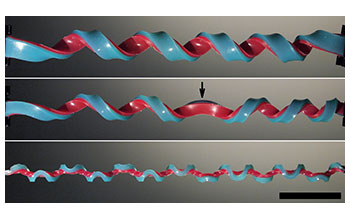Multimedia Gallery
Scientists discover hemihelix shape
Illustration of a helix (top), a hemihelix with one perversion (marked by an arrow, middle), and a hemihelix with multiple perversions (bottom). The scale bar is 5 centimeters for each image.
Helices are 3-D structures similar to a corkscrew or a Slinky toy. Hemihelices form when the direction in which the spiral turns--known as the chirality--changes periodically along the length. The reversal in chirality is called a perversion.
The hemihelix shape is rarely seen in nature. Katia Bertoldi, an associate professor of applied mechanics at Harvard University School of Engineering and Applied Sciences (SEAS), and colleagues stumbled upon the shape by accident while trying to make new springs using two strips of rubber material. The rubber pieces were of different lengths. The researchers stretched the shorter strip to reach the length of the longer piece and stick them together.
"We expected that these strips of material would just bend, maybe into a scroll. But what we discovered is that when we did that experiment, we got a hemihelix and that it has a chirality that changes, constantly alternating from one side to another," said David Clarke, the Extended Tarr Family Professor of Materials at SEAS.
Bertoldi and Clarke believe their findings provide important clues for how to fabricate a variety of 3-D shapes from flat parts. The research could help scientists twist and turn biological molecules and advance nano devices such as sensors and resonators.
The work was supported in part by the Harvard Materials Research Science and Engineering Center, which is supported by the National Science Foundation (grant DMR 08-20484). [Also, related NSF grants CMMI 11-49456, under the Faculty Early Career Advancement (CAREER) program, and CMMI 13-33835.]
To learn more, see the SEAS news release Scientists characterize a new shape using rubber bands. (Date of Image: 2014)
Credit: Jiangshui Huang, Harvard University
Images and other media in the National Science Foundation Multimedia Gallery are available for use in print and electronic material by NSF employees, members of the media, university staff, teachers and the general public. All media in the gallery are intended for personal, educational and nonprofit/non-commercial use only.
Images credited to the National Science Foundation, a federal agency, are in the public domain. The images were created by employees of the United States Government as part of their official duties or prepared by contractors as "works for hire" for NSF. You may freely use NSF-credited images and, at your discretion, credit NSF with a "Courtesy: National Science Foundation" notation.
Additional information about general usage can be found in Conditions.
Also Available:
Download the high-resolution JPG version of the image. (4.3 MB)
Use your mouse to right-click (Mac users may need to Ctrl-click) the link above and choose the option that will save the file or target to your computer.

